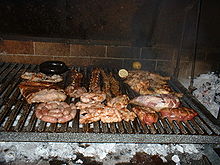Argentine beef
Due to the geography of the Pampas and a small national market, the cattle multiplied rapidly, with some contemporary observers describing the animals as a menace.
Argentine beef and its production have played a major part in the culture of Argentina, from the asado to the history of the gauchos of the Pampas.
Landowners became wealthy from beef production and export, and estancia owners built large houses, important buildings in Buenos Aires and elsewhere, and contributed to politics, philanthropy, and society.
The agricultural show La Rural each winter in Buenos Aires became a major part of the social season since it started in 1886.
In Chile, heightened taxes for the import of Argentine cattle in 1905 led to the meat riots, one of the first massive protests in Santiago.
The price of meat was kept artificially high by the government, by means of the combination of a special tariff applied to cattle imports from Argentina, to protect the domestic producers, and a runaway inflation.
[8] On 26 May, the ban was replaced by a quota, to be in force between June and November, equivalent to 40% of the amount of beef exported in the same period of 2005.
These measures met harsh criticism from livestock farmers, the meat processing industry, and the export sector; some analysts have said that it will be useless in the long term and harm Argentina's international image, besides causing large monetary losses.
The unsatisfactory situation concerning food safety becomes immediately clear by looking at the fact that the Argentine National Inspection Services audited and approved only 35 slaughterhouses in 2003 on Good Manufacturing Practices and Hazard Analysis and Critical Control Point (HACCP).
However, farmers as well as the export industry started to realize that there is a steadily increasing demand for safer and more reliable brands.
To increase sales in foreign countries and to improve the production and reliability of beef produced in Argentina, a public nongovernmental organization, the Instituto de Promoción de la Carne Vacuna Argentina— the Argentine Beef Promotion Institute (IPCVA) was founded in December 2001.
The IPCVA is made up of a range of partners involved in Argentine beef production and export, from experienced cattle farmers to managers.
Nowadays, Argentina's Shorthorn breed has been bred to greatly improve its meat quality thanks to hybridisation (crossbreeding) as has been demonstrated at the National Agropecuarian Technology Center.
[13] Produced with the objective of responding to England's food market expansion during Britain's industrial revolution the Hereford is known for its high yield of beef.
Characteristics: high yield of beef; wide back; early maturity; rustling ability and hardiness.
Characteristics: maternal skills; highly fertile; growth capacity; climate adaptation; thin skin; short and smooth hair.
[15] Derived from the Holstein, it was first introduced from the Netherlands in 1880, to the fertile regions of the Pampas, and devoted to the production of both beef and milk.
Characteristics: light colored; clear hump between the shoulders; large horns; hot climate and insect tolerance.
Characteristics: wide opened and round horns; long and tall; projecting shoulders and deep hips.
[17] Beef is traditionally cooked over charcoal flame (as an asado) and served often as part of a wider selection of grilled meat, with chimichurri as a relish.



